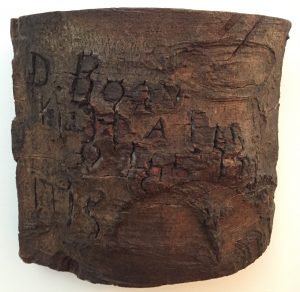Exchange Place Living History Farm represents a working farm in Northeast Tennessee during the antebellum period (1830s-1850s). Before white settlement, the land on which the site is located was used by Native Americans whose arrowheads can still be found in the turned soil of the gardens and fields. In 1750, the property became part of a massive, three thousand-acre land grant given by British Colonial Governor Robert Dinwiddie to Edmund Pendleton, a member of the Virginia House of Burgesses (and future member of both Continental Congresses and Chief Justice of Virginia).
Pendleton never settled on this property, in what would later become part of the state of Tennessee, but instead appointed his nephews, James and Thomas Gaines, to act as his agents and sell the land in approximately 200-acre tracts. Thomas’s grandson, John Strother Gaines, acquired one of these tracts, which was adjacent to his father-in-law’s farm on Reedy Creek. John, a veteran of the War of 1812, and his wife, Letitia Dalton Moore (also his double second cousin), established a homestead on this tract that would later be known as “Exchange Place.” Here, they raised a family of twelve children and eventually amassed over 2,000 acres, making their farm one of the largest in the area.
John Gaines was a wealthy, slave-owning farmer. He was also an entrepreneur and public servant, who served as postmaster of the Eden’s Ridge community and operated a store and stagecoach stop on the Great Stage Road, which he rerouted to pass in front of his house. Many “exchanges” took place at Gaines’s farm: fresh horses were exchanged for spent ones, and goods were bartered and traded for at the store; however, it is likely the exchange of Virginia and Tennessee currency that contributed most to Exchange Place’s moniker. (At that time, each state had its own currency.)
In 1845, John Gaines traded 1182 acres of his land (roughly half of his total holdings), which included the Main House and its outbuildings, to John Montgomery Preston, a wealthy merchant and first mayor of Abingdon, Virginia, for Preston’s Holston Springs property in Scott County, Virginia. Preston ran Exchange Place as an absentee owner and later deeded it to his son James following his marriage to Catherine Greenway in 1847. In 1850, James and Catherine brought their young daughter Ellen to live at Exchange Place where they would remain until returning permanently to Abingdon after the Civil War. In total, they had six children who lived to adulthood, all of whom remained single except for their daughter Kate, who married into the prominent Stuart family of Virginia.
James Preston used enslaved and tenant labor to work his land. (In 1856, he freed two of his slaves, Jefferson and King, and made them tenants.) Preston produced large amounts of corn, wheat, oats and tobacco and raised livestock, primarily hogs, for meat production. He closed down the stagecoach stop and post office and operated the store only for his tenants, not for the general public.
The Preston family owned Exchange Place—which they called their “Tennessee Farm”—for 125 years. In 1970, they donated seven acres of the original homestead, including the Main House and its dependency buildings, to the Netherland Inn Association, a local non-profit organization. The site was subsequently listed on the National Register of Historic Places and developed as a living history museum representing the antebellum era in Northeast Tennessee. Additional acreage was eventually purchased, including “bottom land” on Reedy Creek, making the total holding about sixty acres. The farm complex now includes restored original and reconstructed buildings, heirloom gardens, and heritage livestock and poultry breeds. At festivals and special events, artisans and costumed interpreters bring the past to life through demonstrations of “old time” skills like open-hearth cooking, blacksmithing, spinning, and weaving.
Water color rendering of the Exchange Place farmstead as it might have looked in the mid-19th century
One of the prize possessions of the Preston family is the “Boone Block”—a segment of the trunk of a beech tree that bears the inscription:
D. Boon
Killd A Bar
O This Tre
1775
Family legend says that John M. Preston found this tree while riding over the farm (some stories even claim that the Boone Tree was the reason Preston wanted the property to begin with.) Not long after acquiring Exchange Place, Preston cut the tree down and preserved the portion bearing Boone’s inscription. This portion still hangs in the Preston-Stuart home (“The Bank”) in Abingdon today. A facsimile hangs in the Main House at Exchange Place.

The Boone Block
The mission of Exchange Place Living History Farm is to preserve and interpret the heritage of mid-19th century farm life in Northeast Tennessee. A private, non-profit organization, Exchange Place is maintained and operated primarily by volunteers and is supported by donations, fundraisers, memberships, and grants.

Exchange Place
4812 Orebank Rd,
Kingsport, TN 37664
423-288-6071